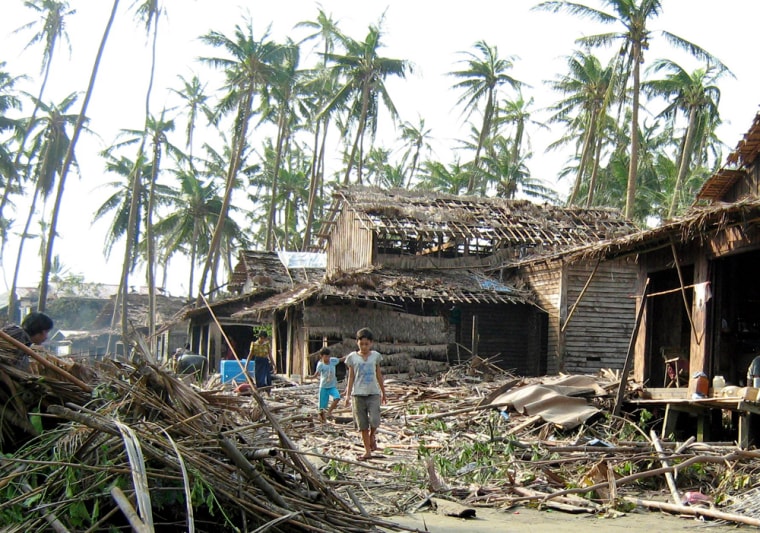Myanmar needs at least $1 billion over the next three years to help rebuild the lives of survivors of Cyclone Nargis, a U.N.-led report said Monday in the first comprehensive assessment of the damage caused by the disaster that killed more than 84,000 people.
The May 2-3 cyclone caused an estimated $4 billion in damage, said the report prepared by the United Nations, the Association of Southeast Asian Nations and Myanmar's military junta. Damage to assets was estimated at $1.7 billion and loss of income at $2.3 billion.
The cyclone devastated large swathes of the Irrawaddy delta and the Yangon region, killing at least 84,537 people and leaving 53,836 others missing and presumed dead, according to the junta.
ASEAN Secretary-General Surin Pitsuwan said the three parties involved in the report are seeking at least $1 billion in international aid for humanitarian relief efforts alone over the next three years to deal with "a tragedy of immense proportions."
"The task ahead is clearly enormous and will take a lot of time, a lot of effort," Surin told a news conference, flanked by the foreign ministers of the 10 ASEAN countries and the U.N. humanitarian chief, John Holmes.
ASEAN helped facilitate contacts between international donors and Myanmar's military junta, which had initially refused to allow in foreign relief workers. The junta had also insisted on full control over international relief, holding up delivery for weeks while survivors waited in desperate conditions.
At a donor conference after the cyclone, participants demanded full access to storm-hit areas and an independent assessment of aid to ensure it was not being wasted or stolen.
"Both of those things are in place," Holmes said. "It is important to have a report of this quality to assure donors that resources are being well spent ... and that future assistance is fully justified," he said, appealing to donors to "continue to be generous."
U.N. short on aid request
He said the U.N. had appealed for $482 million in immediate assistance but is still short $300 million.
The report paints a dismal picture of the devastation caused by the cyclone, saying it is expected to wipe out about 2.7 percent of Myanmar's projected gross domestic product in 2008.
The storm destroyed 450,000 homes and damaged 350,000. About 75 percent of health facilities were damaged, as were 4,000 or more schools.
About 1.5 million acres of farmland and 60 percent of agricultural implements were destroyed, it said. In mid-June, 55 percent of survivors had enough food for only one day or less.
"We have tired to wipe some tears, soothe some aching hearts ... but not all," Surin said. Failure to provide them aid over the long term "will be detrimental to the very survival of the victims," he said.
Report avoids issue of junta's response
The report does not mention the junta's limited action in the first week after the disaster which drew worldwide criticism. Pictures of bodies floating in the water amid reports that soldiers were standing by idly horrified people around the world. The junta also was criticized for failing to accept international aid quickly and even physically preventing it from going to the hardest-hit areas.
Singapore Foreign Minister George Yeo, who chaired the news conference, refused to allow a reporter's question to Myanmar Foreign Minister Nyan Win about whether the junta felt that many lives could have been saved had it acted differently.
Yeo said that while "political questions" are relevant, the news conference was only about the assessment report.
ASEAN experts said the cyclone-hit area remains in a state of emergency.
"People live in a very precarious condition now. If we fail to sustain the recovery efforts, they may face a second emergency," said Puji Pujiono, a recovery assessment specialist in the ASEAN team.
